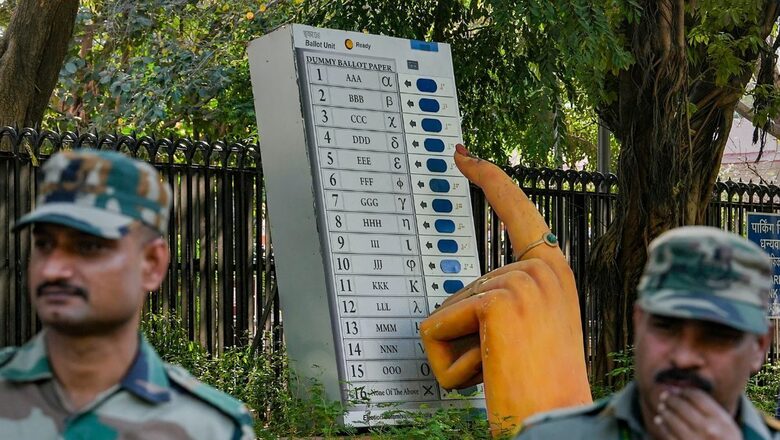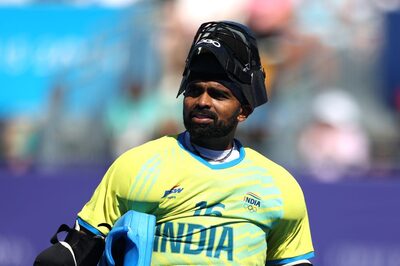
views
Sabarkantha is one of the 26 Lok Sabha constituencies of Gujarat. It comprises seven assembly segments, spread over the Sabarkantha and Aravalli districts: Himmatnagar, Idar, Khedbrahma, Bhiloda, Modasa, Bayad, and Prantij. Apart from Khedbrahma, which has a Congress MLA, the remaining six assembly segments are held by the Bharatiya Janata Party. In the 2019 general elections, the BJP led in all seven Vidhan Sabha segments.
Dipsinh Shankarsinh Rathod from the BJP is the incumbent MP of Sabarkantha, though the party has given its ticket this time to Shobhna Baraiya. The other top contender is Tushar Chaudhary of the Congress. Polling will take place in this constituency on May 7, in the third phase of the ongoing Lok Sabha elections.
Political dynamics
- The BJP is expecting its fourth consecutive Lok Sabha victory from Sabarkantha – a constituency the party has held since 2009. While the BJP is leading in the fight to win this seat from Gujarat, it faces some big problems here – mostly related to internal party differences. Shobhna Baraiya is the saffron party’s candidate from Sabarkantha, but she was not who was initially fielded. The ticket was first given to Bhikaji Damor. However, owing to a controversy over whether he belonged to the Damor or Thakur communities, the party is believed to have nudged him to opt out of the fight.
- Consequently, Shobhna Baraiya was fielded. Baraiya belongs to the Thakor community and has just given up a career in teaching to join active politics. She is the wife of former Prantij MLA Mahendrasinh Baraiya who joined the BJP after quitting the Congress, just ahead of the 2022 assembly elections in the state.
- However, Shobhna Baraiya’s candidature triggered an intense tussle in the party’s local unit. A major resentment among BJP workers in the constituency was the fact that an “outsider” was given the ticket instead of many who have been with the party “all their lives”. The fact that Bhikaji Damor – associated with the party for long – had to roll back his candidature triggered much anger among BJP workers.
- However, it is believed that union home minister Amit Shah’s intervention has, at least on the surface, been able to quell the rebellion. Ground inputs do suggest that there still exists underlying anger against Baraiya’s candidature, but the party is not expected to take a severe hit since the electorate here by and large wants Narendra Modi to return as Prime Minister.
- The Modi factor is alive and kicking here in Sabarkantha. The consensus among voters is that Modi is doing a good job and deserves to remain Prime Minister. There are definitely local issues that the electorate is concerned about, but the sentiment is that only the BJP can resolve them.
- Shobhna’s husband, Mahendrasinh Baraiya, is seen as accessible and helpful by the people in the constituency, who has stood by them whenever they require help. This adds more muscle to Shobhna Baraiya’s campaign.
- Besides, the BJP candidate is also known to be close to Praful Khoda Patel – who is widely recognised as one of PM Modi’s trusted aides. In Sabarkantha, Patel is a widely known and appreciated leader who people say has done a lot of good work for the constituency, especially during his tenure as state home minister. This is another factor that will play to Shobhna Baraiya’s advantage.
- However, apart from internal party differences, the BJP candidate is also having to face the ire of Rajputs. Following Purshottam Rupala’s remarks against the community, the Rajputs in Gujarat are vowing to not allow BJP leaders entry into villages and are also working to ensure the party is defeated. While their impact, especially in Sabarkantha, is expected to be limited, they are nevertheless proving to be a headache for the BJP and its campaign. Shobhna Baraiya is campaigning in areas where Rajputs are staging protests while being flanked by police personnel wearing body cameras. In such areas, the BJP has reworked its campaign strategy. Instead of big events, Shobhna Baraiya is canvassing by visiting individual homes and interacting with a limited number of people.
- The BJP’s biggest poll plank in Sabarkantha, like in the whole of Gujarat, is very development-centric. The saffron party is essentially seeking a referendum on the work done by the Modi government over the past 10 years while promising to double down on the “vikas” front to transform India. The saffron party’s message is largely seen to be resonating with the people, who realise that this is a national election where local issues can take a backseat.
- The Congress is hoping that resentment over some local issues faced by the public here will help it. The strategy, however, is not expected to deliver any substantial results, given how the voters here appear to favour the BJP for local issues’ resolution as well.
- Another important pillar of the Congress’s campaign is its candidate, Tushar Chaudhary. While candidates do not appear to be playing a very important role in the BJP’s scheme of things, in Sabarkantha, Tushar Chaudhary is all that the Congress is relying on. Chaudhary, son of former Gujarat chief minister Amarsinh Chaudhary and a former union minister of state himself, is boasting about his connections in the power corridors of New Delhi.
- A campaign point Chaudhary is making is the fact that he supposedly knows all the important offices and ministries in the national capital. This, apparently, makes him a candidate ready to represent Sabarkantha in the Lok Sabha. On the other hand, the Congress is trying to convince voters not to vote for the BJP candidate who is unaware of how things go about in Delhi.
- Besides, Tushar Chaudhary has some legacy goodwill here in Sabarkantha. His father, former CM Amarsinh Chaudhary, is widely respected for standing as a pillar of support for the people, especially during times of drought.
- The Congress is also focussing on unemployment, price rise, and water-related issues to pitch itself as an alternative to the BJP.
- However, the Congress does not appear to be in a winning position in the constituency – and that is by a wide margin. For the people, the BJP is the first, and in many cases, the only choice.
- Adding to the Congress’s woes is Rahul Gandhi’s recent remarks against Praful Patel – who is now the administrator of Dadra and Nagar Haveli and Daman and Diu & Lakshadweep. Rahul Gandhi has said that once the INDIA bloc forms the government at the Centre, the sacking of Patel will be taken on as a priority task. In Sabarkantha, where Patel is widely respected and admired, this remark by Gandhi is expected to further dent the Congress’s prospects.
Key issues
Communal clashes: Himmatnagar saw repeated communal clashes in 2020 and 2022. The 2022 clash witnessed fierce stone-pelting and arson as the police had to impose section 144 in the region. Incidents of burning vehicles, stone-pelting, and vandalism of homes and businesses were also widely reported. Many Muslim shops, mosques, and dargahs were set on fire. 45 people across both communities were arrested. With elections fast approaching, communal faultlines and religious polarisation will play a key role in the constituency dividing voters. Communal tensions are once again on the rise, as on February 15 this year, one person was killed when clashes erupted between members of two communities in Prantij town over a financial dispute.
Welfare schemes: The PM Ujjwala Yojana and the PM Awas Yojana have been successfully implemented in the region. However, in the tribal belt, the welfare schemes have failed to find their way in the manner they should have. In addition, the faulty implementation of the Jal Jeevan Mission can be felt throughout the region, but more so in the tribal belt. According to ground inputs, while on paper the scheme has been successfully implemented in the tribal areas, officials often carry a tap and a pipe to these parts, get photos clicked, and leave. This has miffed the tribals who have been hoping the government will provide them with better amenities.
Connectivity: Connectivity has been a major demand of the locals, especially farmers here in Sabarkantha. People had demanded broad gauge rail lines and electrification for regular supply of seeds, fertilisers, and other public goods. The issue was promptly addressed by the government and has left a certain impact on the voters. It will play a crucial role in the elections as people are in gratitude to the government for adhering to their demands and this will prove crucial for the BJP, which is hoping to retain the seat for the 4th time in a row.
Idariyo Gadh: Idariyo Gadh, a place rich in granite deposits, has become a battleground between locals and leaseholders since 2016 when talk of mining arose. The community has fought tirelessly to protect its mountains and natural resources, but mining has already commenced across a vast area. Concerns have been raised about the potential violation of laws to facilitate this activity. Idariyo Gadh holds immense ecological, historical, and cultural significance, with numerous religious sites like Jain temples and Islamic shrines dotting the landscape. Disturbingly, visitors have reported cracks appearing in the walls of several temples and a dargah following the onset of mining operations. The mining operations stopped when Mohan Bhagwat visited the site and assured the locals that no more mining would be done in the area. But now, with elections round the corner, people fear that if BJP wins, the mining will start again as rampant mining and intensive investments were allegedly linked to Anar Patel, daughter of former Gujarat chief minister Anandiben Patel.
Unemployment and emigration: There are no major industries or manufacturing hubs in the region. The ceramics industry was one of the biggest sources of employment here, but it has been on a steady decline over the past five years. According to ground reports, there were up to 18 ceramic plants in the region of which only 2-3 have stayed open. This drastic decline has left the youth hopeless and has also created a wave of emigration towards Maharashtra, and Madhya Pradesh in search of better economic opportunities.
Tribal issues: The tribal belt of Sabarkantha has not seen any development. There is little to no road connectivity in the tribal areas, making mobility a challenge for the locals. In addition, there are some villages in the region that have not seen electricity since Independence. Civic amenities such as schools, hospitals, and running tap water cease to exist here, leaving the tribals to fend for themselves.
Drinking water: Sabarkantha, along with other areas in Gujarat, is facing a concerning issue with its groundwater levels. Harmful chemicals like fluoride, arsenic, and lead have been detected, posing a risk to human health. This contamination is attributed to factors such as population growth, industrial activities, and urbanisation. Adding to the problem, the groundwater level in Sabarkantha is dropping by a metre annually, forcing deeper drilling to access this essential resource. This has also led to a rise in illnesses and deaths related to water contamination as people in rural areas in the region do not have access to health infrastructure.
Demographics
- Total voters: 17,97,211
- SC: 141,980 (7.9%)
- ST: 366,631 (20.4%)
- Urban voters: 274,973 (15.3%)
- Rural voters: 1,522,238 (84.7%)
- Hindu: 97.7%
- Muslim: 1.7%
Infrastructure development
Asarva-Himmatnagar-Udaipur Gauge Converted Line: The completion of this railway line, spanning 299 kilometres and costing over Rs 2,482 crore, marks a significant development for the region. It has enhanced connectivity for residents of towns like Himmatnagar, Nandol Dehgam, and Dungarpur, providing them with easier access to the rest of the country. It also holds immense potential for boosting tourism, trade, and industrial growth in the area. It is also believed that this line will aid industrialisation in the region by providing better connectivity to Delhi and Mumbai.
Six-laning of Shamlaji-Mota Chiloda highway section: The 15-km long Chiloda-Naroda highway section joins Gandhinagar with Ahmedabad. The total cost of developing the 6-lane stretch is Rs 247 crore. With the construction of this highway, traffic from Himmatnagar can now merge with SP Ring Road at Nana Chiloda Ring Road circle, providing access towards Vadodara through National Expressway 1.
Railway infrastructure: Many railway infrastructure projects have been completed or are already underway in the Sabarkantha Lok Sabha constituency. Some of them are the Himmatnagar-Khedbrahma line, the Vijapur-Ambliyasan line, and the Adraj Moti-Vijapur Gauge converted line works. Along with these, many upgrades to improve passenger amenities have also taken place such as installation of water fountains at many stations across the region and footbridges along with shade development at stations.
Tourism: Three areas in Sabarkantha – Idar, Vijaynagar, and Polo – are being developed for ecotourism. Adventure sports facilities for rock climbing, mountaineering, paragliding, renovation, rehabilitation, and development of heritage sites like Old Palace, Rani Talav, Idar Kund, Rajchandra Vihar, and other ancient structures are on the cards, in addition, the development of scenic spots like sunset point, echo point, lake, etc, are also being considered. Elephant rides in Polo Forest and the development of a tribal museum, etc, are in the works. The estimated cost of the development is Rs 200 crore.
Check Lok Sabha Election 2024 Phase 3 Schedule, Key Candidates And Constituencies At News18 Website.
















Comments
0 comment